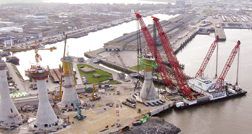 C-Power N.V. Cast In Belgium, 2,700-Tonne Concrete Wind-Turbine Bases Are Headed Offshore.
|
Installed 30 km off Belgium since late April, the hollow, prestressed 2,700-tonne concrete bases are the first of the $240-million, 60-unit Thornton Bank farm. The 300-MW first phase is due for completion this September.
With 126-m-dia. blades, the turbines will sit on 6.5-m-dia. steel pylons rising 77 m from the gravity bases. The 44-m-tall bases comprise cylindrical shafts cast atop 17-m-tall cones, which spread to 23-m-dia. Their walls are generally 50-cm-thick.
|
A traditional steel “monopile” driven into the seabed was studied but rejected, says Geert Dewaele, construction manager for the owner, C-Power N.V., Zwijndrecht, Belgium. Needing to be 6-m-dia. with 6-cm-thick walls, “no company was able to put these piles in place,” he adds.
Dredging International N.V., Zwijndrecht, leads construction and installation of the gravity bases, under a $65-million contract started last August.
“As every single casting section [of the cone] has a different diameter, there [were] five separate sets of formwork in service,” says a spokesman for Austria’s Doka Industrie GmbH., Amstetten. Units of the firm supplied the climbing formwork to the casting site in Ostend, Belgium.
A 440-tonne-capacity crane barge transported and placed the last base into a dredged trench early in June. After backfilling the trenches and placing rock erosion protection, the contractor will ballast the bases with sand.
s offshore wind turbines grow in power, they need increasingly robust supports. Six of the world’s biggest new-generation concrete gravity bases have recently been placed in depths up to 27 m in the North Sea to carry 5-MW turbines. Then, under a separate $75-million contract, Germany’s REpower A.G., Hamburg, will be responsible for placing completed assemblies of turbines, blades and pylons. The first steel pylon was due in Ostend about June 19. Related Links:
Related Links: 
Post a comment to this article
Report Abusive Comment